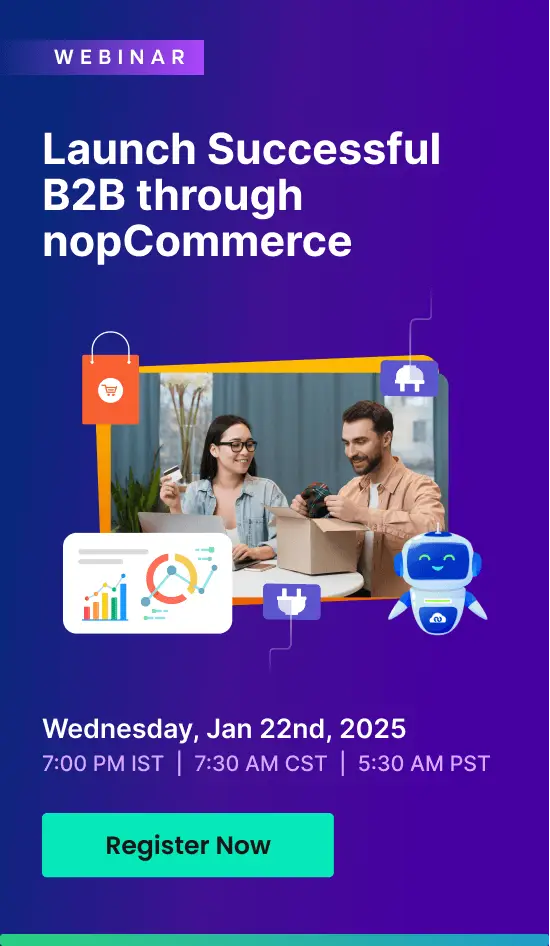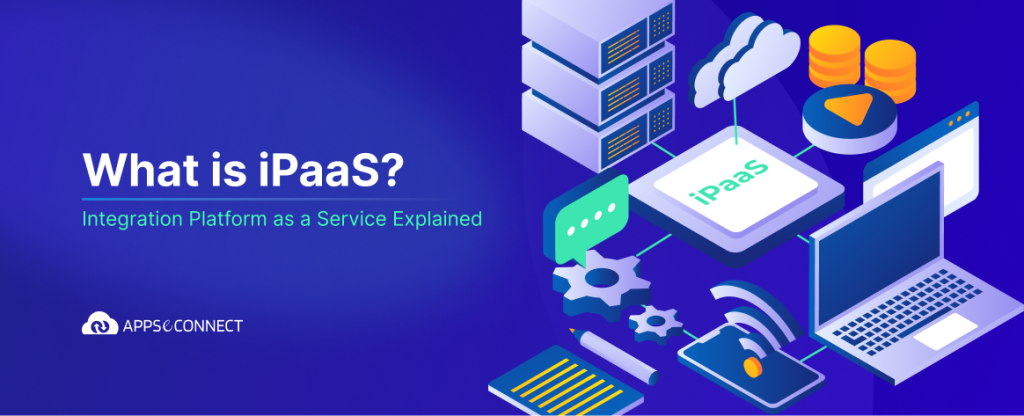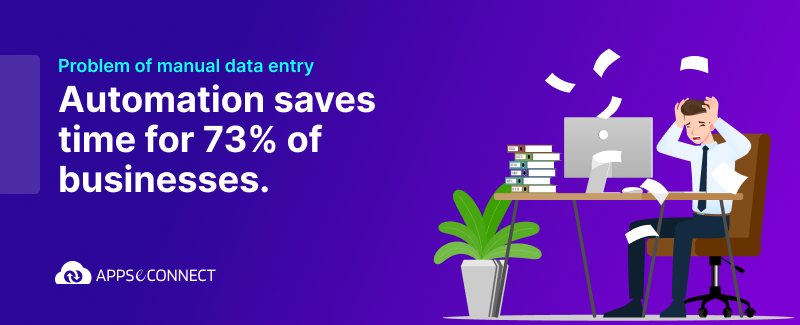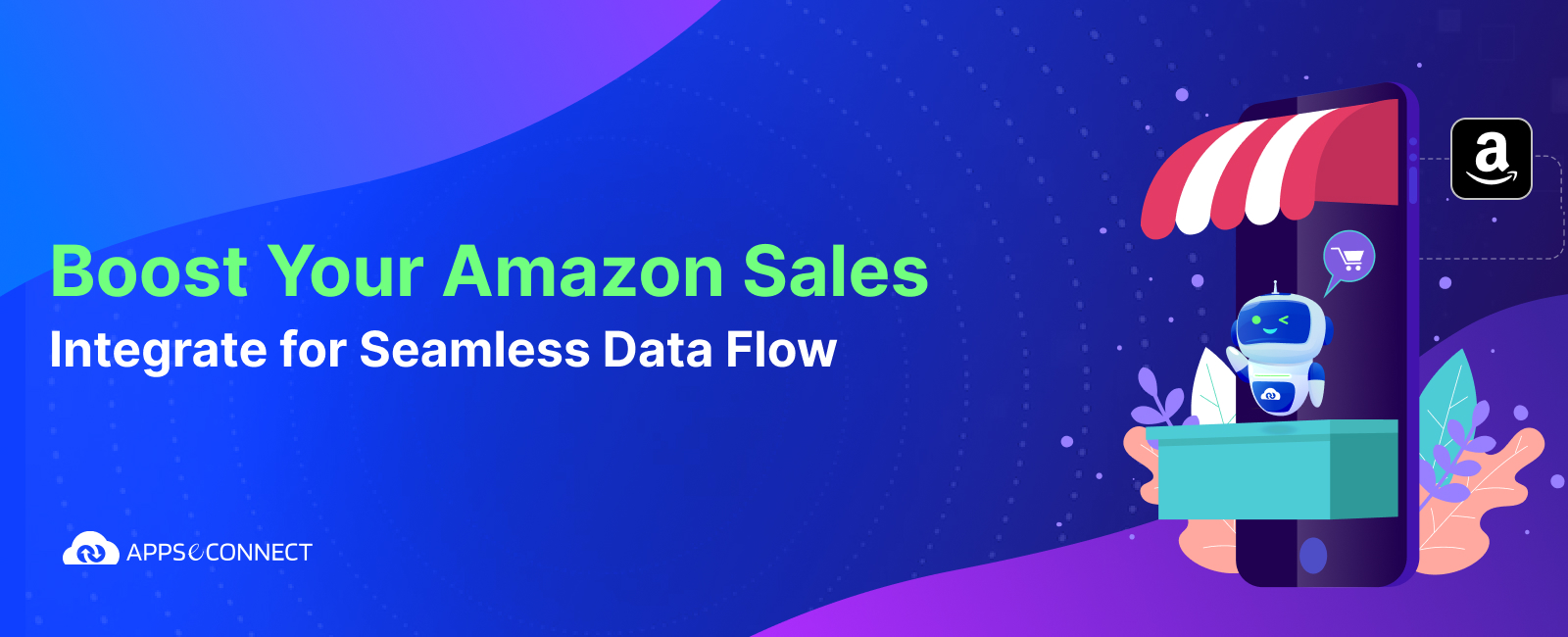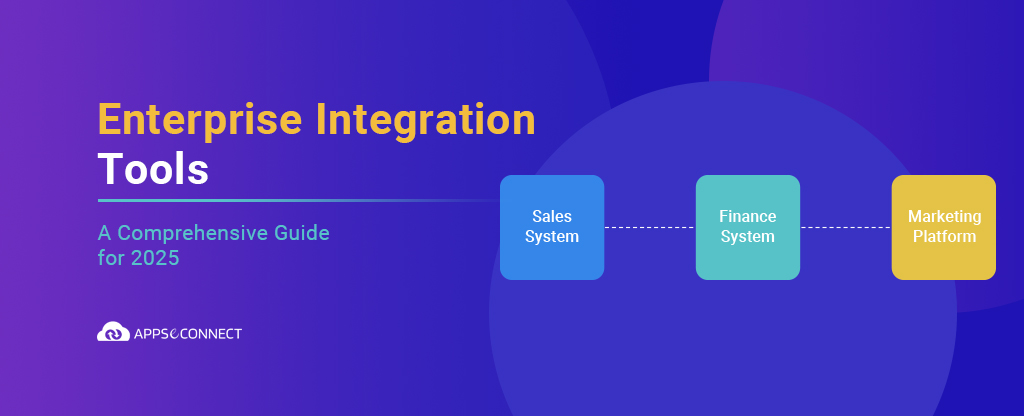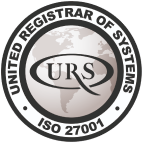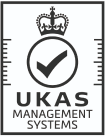Companies today use more than 100 SaaS applications on average. In 2015 this number was just eight. However, the rapid expansion has created a major challenge for businesses- integration of all these applications under one workflow.
As data shows, 82% of tech professionals face errors and backlogs with app integrations and workflow automation.
iPaaS resolves these integration challenges. iPaaS platforms connect multiple applications and automate data flows without complex coding.
Organizations can now simplify their processes, reduce costs, and eliminate manual data entry tasks through automated workflows.
In this article, we will discuss what iPaaS is and how iPaaS solutions can automate your business operations.
You’ll also learn about the top iPaaS features, real-life success stories, and everything you need to know when choosing the right iPaaS platform that fits your needs.
What is iPaaS: core concepts and architecture
Talking about modern enterprise integration solutions, iPaaS is leading the way. As data showcased on Grand View Research, the iPaaS market is set to reach $71.35 Billion (EXT) by 2030. These cloud-based platforms make shared connectivity possible between different systems, applications, and data sources across multiple environments.
What is an integration platform as a service (iPaaS)?
iPaaS works as a unified platform that manages integrations and data flows across cloud and on-premises applications. The platform provides automated tools to connect software applications deployed in different environments. The system coordinates workflows across multiple applications through a centralized integration system, handles the full lifecycle of APIs, and automates business processes.
Key components of an iPaaS platform
The architecture of an iPaaS solution includes several core components that work together to ensure smooth integration:
- Data integration layer: Connects different data sources through connectors, APIs, and data transformation tools.
- Process integration layer: Coordinates and automates business processes through workflow engines.
- Security and governance layer: Manages authentication, authorization, and data encryption mechanisms.
- Monitoring and management layer: Provides tools to monitor, manage, and optimize integrations.
iPaaS platforms come with pre-built connectors and templates that make the integration process simple without extensive coding. These platforms support integration patterns of all types, including data synchronization, API integration, and event-driven architectures.
How is iPaaS different from traditional middleware?
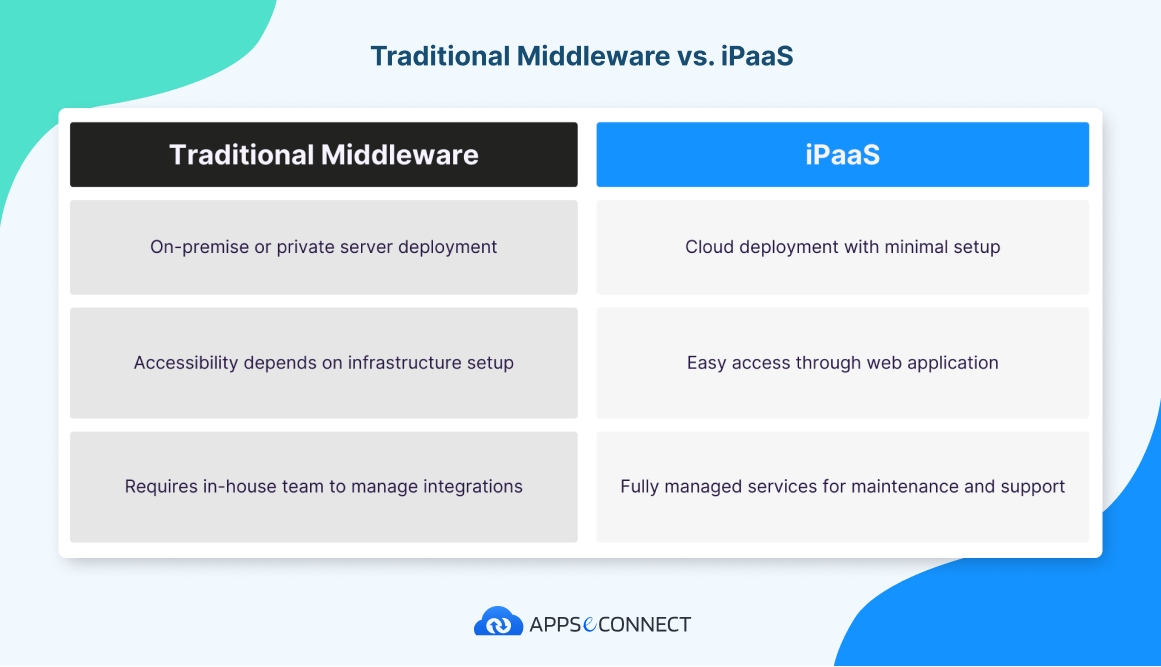
Traditional integration methods rely on on-premises infrastructure and just need significant maintenance. iPaaS brings several unique advantages over these conventional approaches:
Deployment model
Traditional middleware requires on-premises or private data center deployment. iPaaS operates through cloud-based services managed by third-party providers. This change eliminates the need for extensive infrastructure setup and maintenance.
Accessibility and scalability
iPaaS platforms are more accessible through internet-based operations and can adjust resources based on needs. Traditional middleware often needs additional infrastructure setup to expand.
Management approach
iPaaS providers handle infrastructure management, updates, security, and monitoring. This managed service model reduces the burden on internal IT teams by a lot compared to traditional integration methods that need extensive in-house management.
The platform supports almost all data management patterns across multi-cloud and hybrid environments under one user-friendly interface. This unified approach helps organizations design automated workflows and integration patterns faster with self-service wizard builders.
Want to explore the best iPaaS solutions for enterprises? Click below:
The business case for iPaaS implementation
The business case for iPaaS needs a deep look at real financial returns and operational benefits. Recent studies paint a clear picture of how valuable iPaaS can be for organizations of all sizes.
Calculating ROI from iPaaS adoption
iPaaS adoption brings impressive financial returns according to multiple studies. Companies that use iPaaS solutions see an average ROI of 413% and recover their investment in just four months.
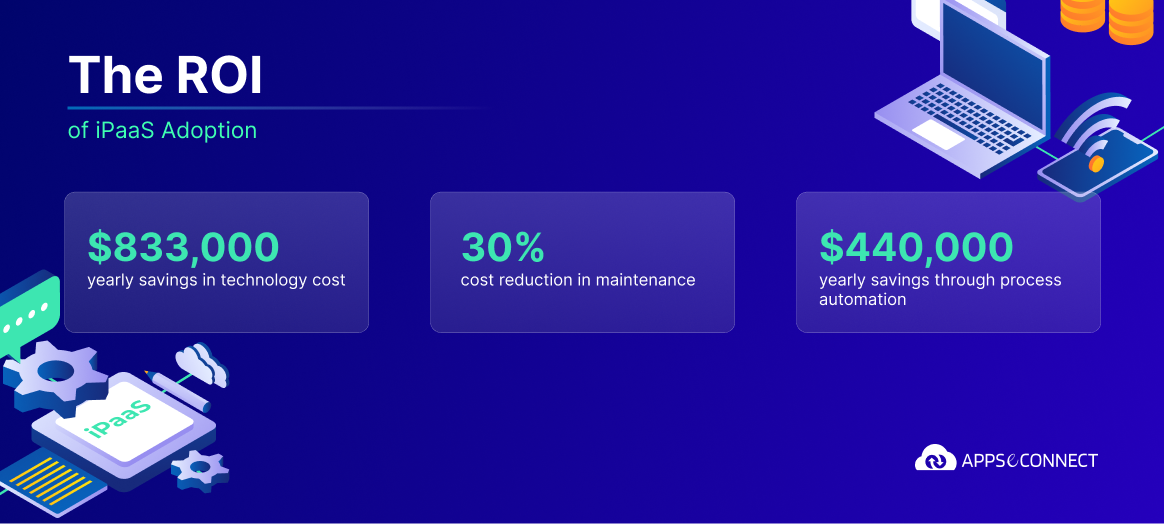
These businesses achieve yearly benefits of USD 2,201,369. The returns flow from three main areas:
- Technology cost reduction: USD 833,000 yearly savings by combining multiple integration tools.
- Support cost optimization: 30% less spending on maintenance.
- Process automation benefits: USD 440,000 saved each year through automated workflows.
Cost comparison with traditional integration methods
Traditional integration methods don’t match the cost benefits of iPaaS. A single traditional integration connection costs between USD 7,000 and USD 15,000. The yearly maintenance runs between USD 7,425 and USD 14,851 per integration.
iPaaS cuts out big upfront hardware and infrastructure investments. Companies finish integration projects 70% faster. The pay-as-you-go model lets businesses use only what they need without buying extra hardware or software.
Measuring business impact and performance metrics
iPaaS brings clear improvements to business metrics beyond just saving money. The numbers tell a compelling story.
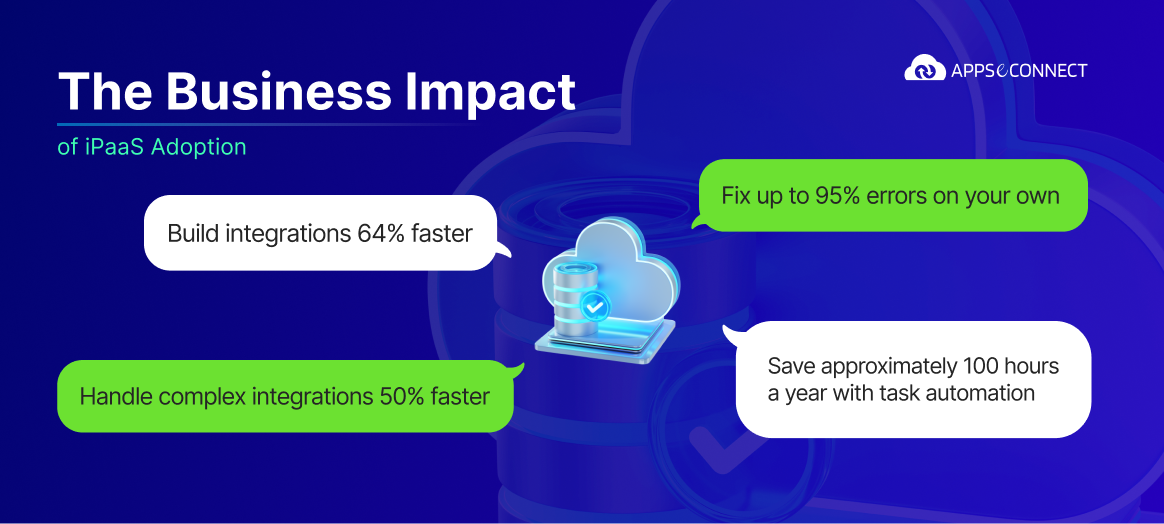
Teams build new integrations 64% faster. The platforms work smarter too – they fix up to 95% of integration errors on their own.
Teams save roughly 100 hours each year by automating manual data tasks. One company freed up 12 developers after switching to iPaaS and saved over a million dollars yearly.
iPaaS platforms help businesses handle complex integrations 50% faster. Error rates drop significantly, with some teams seeing half as many integration problems each month.
Calculate the ROI of iPaaS adoption for your business using our free ROI calculator
iPaaS ROI calculator – free tool
Essential Features of Modern iPaaS Solutions
Modern iPaaS platforms come with advanced features that go beyond simple integration features. These platforms focus on three key areas that show how well they work in enterprise environments.
Data integration and transformation capabilities
iPaaS solutions’ foundations rest on knowing how to process, clean, and transform data across multiple formats, especially ASN.1, XML, and JSON. These platforms do more than just move data. They support live processing and batch data integration methods. Their transformation features help organizations coordinate data across their ecosystem. This creates a standard format that keeps all connected systems consistent.
API management and connectivity options
API management is the life-blood of modern iPaaS platforms. These solutions provide complete API lifecycle management tools that help create, deploy, and monitor APIs. Pre-built connectors and templates reduce development time by a lot. API-driven approaches make critical application interactions easier and provide analytics to monitor API performance.
Security and compliance features
Security mechanisms are essential to iPaaS platforms, which use multiple protection layers and compliance certifications. These platforms include:
- Access Controls: Role-based access management and multi-factor authentication
- Data Protection: Encryption for both data at rest and in transit
- Compliance Standards: Support for various certifications:
- ISO Certification for privacy and security practices
- SOC 1/SOC 2 for financial reporting and operational controls
- PCI-DSS for payment card transaction security
- FedRAMP/StateRAMP for government agency requirements
These platforms also include resilient monitoring features that track all data activity. They provide detailed audit trails of data access and changes. This integrated security approach keeps sensitive information protected while meeting regulatory requirements in different industries.
The platforms excel at maintaining security in hybrid environments and protect data as it moves between on-premises systems and cloud applications. Their security framework combines resources across multiple clouds while maintaining consistent protection standards.
iPaaS Implementation Strategy
A well-laid-out plan and systematic execution are vital for iPaaS implementation success. The right approach will give optimal integration outcomes and minimize disruptions to existing operations.
Assessment and planning phase
You need a full picture of your current integration landscape before starting implementation. This phase involves reviewing your cloud migration strategy and how it lines up with your organization’s goals. You should identify teams affected by integration gaps, especially those that don’t deal very well with data access across multiple siloed applications.
The planning phase needs input from the core team across departments:
- Lines of business representatives
- Security teams
- End-users
- Senior management
You should define clear functional and non-functional requirements right away, whether you’re replacing an existing integration solution or implementing a new one. This helps set precise test success criteria and gives clarity to everyone involved.
Development and integration methodology
The development phase uses a three-stage approach to get optimal results. The first stage focuses on onboarding and enablement through basic training for all team members. Team members’ technical expertise might vary, but everyone should understand the platform’s capabilities to work together effectively.
A dedicated Tiger Team comes next – a cross-functional group of experts including project managers, technical leads, and deployment specialists. This team takes charge of specific tasks to encourage accountability and speed up decision-making during implementation.
Even the best iPaaS solution might underperform without proper configuration. Your integration strategy should determine data flow requirements between systems. You’ll need to set up connections for both cloud-based and on-premise applications while planning key components like data mapping and API management.
Testing and validation approach
Testing plays a significant role in iPaaS implementation. Start with detailed functionality testing of data flows and configurations. The platform should know how to handle processing with high data loads. So, you need a thorough testing process that spots and fixes potential problems before full deployment.
Track performance metrics by monitoring live data flows through platform dashboards. The system should automatically fix up to 95% of integration errors, regardless of integration complexity. Early problem detection happens through regular monitoring, while optimization makes the system work better.
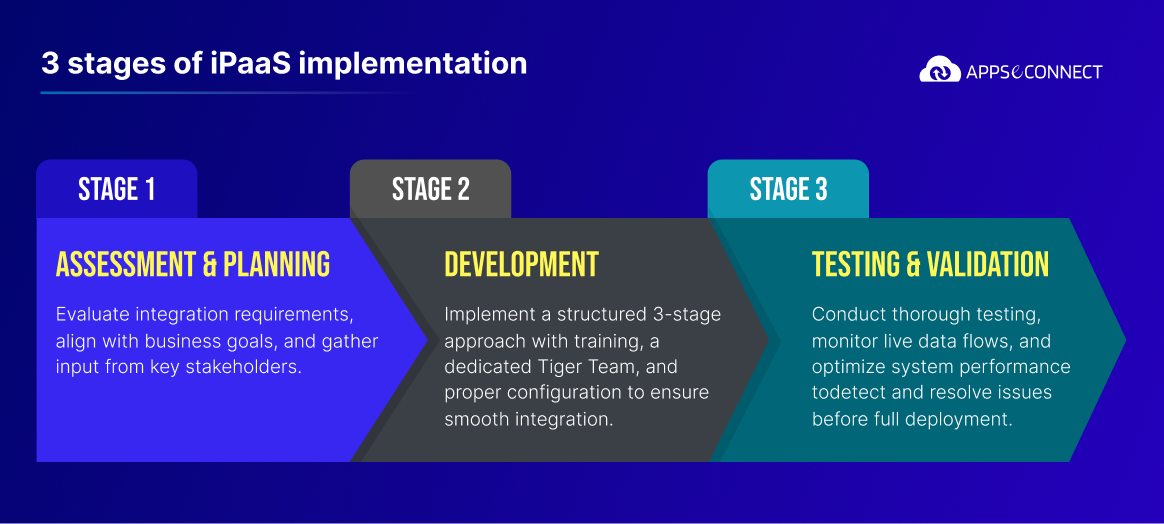
Note that iPaaS implementation isn’t just a one-time project – it needs ongoing maintenance and optimization. Regular updates keep you connected with advanced features and latest technologies. Your iPaaS solution can adapt to changing business needs and maintain peak performance through continuous monitoring and refinement.
Real-World iPaaS Success Stories
Success stories from real-life applications show how iPaaS solutions benefit companies of all types. Healthcare providers and manufacturing giants have achieved remarkable results by implementing iPaaS solutions.
Enterprise digital transformation case studies
Healthcare providers have improved their efficiency through iPaaS adoption. Northwest Kidney Centers blended their Electronic Health Records (EHR) system with Salesforce CRM. This integration led to better patient care and less administrative work. A major U.S. hospital system focused on data synchronization and automated their billing and insurance claims. The result was shorter patient wait times.
Schneider Electric stands out as a successful example of large-scale implementation in manufacturing. The company connected its manufacturing software to supply chain management systems through iPaaS. This connection gave them access to up-to-the-minute data and helped make better decisions. KPMG automated their payment processing system with iPaaS. The new system offered instant payment status updates and better efficiency.
SMB implementation examples
Small and medium businesses have seen big gains from iPaaS adoption. NaphCare, a healthcare service provider, automated their IT account setup using iPaaS. The automation cut down task completion time from one week to under five minutes.
Palm Beach State University shows another success story. The institution used iPaaS to:
- Create unified student interfaces showing education plans and progress
- Populate administrative dashboards with up-to-the-minute data
- Synchronize information across multiple systems
Hammitt, a retail company, achieved impressive results by connecting Shopify Plus with NetSuite ERP through iPaaS. The connection enabled instant data sharing and automated order flows. These improvements helped double their sales since 2019.
Measurable business outcomes
Companies that implement iPaaS solutions achieve substantial, measurable results. The changes go beyond technical improvements to create real business value. Cerner, a healthcare technology company, used iPaaS to connect various systems. The results included:
- Better patient portal functionality
- Quick access to health records
- Efficient appointment scheduling processes
Financial numbers tell a compelling story. Organizations report an average ROI of 413% and recover their investment in four months. Businesses save an average of USD 2,201,369 yearly through iPaaS implementation.
The benefits go beyond money. Sana Commerce, an e-commerce platform provider, connected their system with SAP Business One through iPaaS. The connection eliminated manual data entry errors and made customers happier. Girl Trek, a public health nonprofit, solved their customer data sync issues by connecting Shopify with Salesforce through iPaaS.
Check out more iPaaS success stories. Witness the digital transformation of businesses like yours.
Common iPaaS challenges and solutions
Organizations face several challenges during iPaaS implementation and adoption, despite its many advantages. A successful deployment depends on understanding these obstacles and their solutions.
Technical implementation hurdles
Multiple application integration creates complex technical challenges. Data mapping between different systems remains a big concern. Teams must line up varying data models and structures to ensure accurate data translation. Without doubt, systems using incompatible communication methods create more complications due to protocol mismatches.
Old legacy systems create another major challenge. These outdated systems don’t work well with modern technologies. Teams need to think about:
- Compatibility issues between old and new systems
- Data organization and transmission differences
- Custom interface requirements for smooth operation
Note that system-wide integrations can slow down performance and create latency issues. Performance characteristics might change when teams rewire iPaaS flows at each new integration point. Organizations should use automated data segmentation and test data management with expandable architectures to handle these challenges.
Organizational change management
iPaaS implementation needs more than just technical know-how – it needs solid change management strategies. Getting stakeholder support plays a vital role in success]. Teams must deal with resistance head-on through complete training and support programs.
Failed transformation projects often result from poor application integration. Organizations should focus on these key areas:
- Getting stakeholders involved early in decisions
- Creating quick feedback loops
- Supporting citizen integrators with low-code solutions
- Teaching teams about best practices and security guidelines
Of course, clear communication about iPaaS benefits helps manage resistance to change. Success stories and program milestones should be celebrated to boost adoption. Stakeholders feel more ownership and less imposed upon when they take part in making decisions.
Security and compliance concerns
Security stays at the forefront of iPaaS implementation. The platform processes sensitive data as it moves between applications. Several security aspects need careful evaluation:
Data protection measures:
- End-to-end encryption for data in transit and at rest
- Role-based access controls and multi-factor authentication
- Data Loss Prevention (DLP) policies
Compliance requirements: Teams must address these regulatory standards:
- GDPR data considerations
- PCI-DSS compliance
- HIPAA requirements
- SOC 1 and SOC 2 certifications
Security assessment should match risk levels. Organizations should check and review independent audit reports from iPaaS providers. Encryption plays a very important role, even when regulations don’t strictly require it.
Modern IT environments need strong access controls in iPaaS solutions. System-wide compromise can happen through unauthorized access to integration points]. Strong authentication mechanisms and access policies must be in place to keep unauthorized entities away from critical integration points.
Conclusion
iPaaS platforms have become vital tools that modern businesses need for integration. Companies achieve remarkable returns on investment, with average ROI of 413% and they recover costs in just four months. Teams save nearly 100 hours each year on manual tasks because these platforms remove complex coding needs and deliver automated workflows.
Success stories from healthcare, manufacturing and retail sectors show how versatile iPaaS can be. Northwest Kidney Centers and Schneider Electric’s operations have seen revolutionary changes through optimized data flows and immediate system connectivity. Small businesses report great results too, with some seeing their sales double after implementing the platform.
Security stands at the core of iPaaS solutions that provide detailed protection through encryption, access controls and compliance certifications. Businesses can connect their systems with confidence while keeping their data safe and meeting regulatory requirements.
Successful iPaaS implementation needs careful planning, systematic deployment and regular optimization. A proper assessment, testing and validation process helps you avoid common pitfalls and get the most from your platform. This technology keeps evolving and offers sophisticated features that help businesses compete effectively in our interconnected world.
References:
[3] – https://www.cio.com/article/303605/key-challenges-with-ipaas-and-how-to-resolve-them.html
[5] – https://www.techtarget.com/searchcloudcomputing/definition/iPaaS-integration-platform-as-a-service
[7] – https://www.ibm.com/think/topics/ipaas
[8] – https://www.starfishetl.com/blog/How-iPaaS-Protects-Sensitive-Data-and-Complies-Privacy-Regulations
[9] – https://reachware.com/blog/ipaas-implementation-step-by-step-guide-to-a-successful-integration
[10] – https://www.teamdynamix.com/blog/the-role-of-ipaas-in-digital-transformation/
[12] – https://www.beehexa.com/blog/top-5-ipaas-challenges-and-how-to-address-them/
Frequently Asked Questions
iPaaS (Integration Platform as a Service) is a cloud-based solution that enables organizations to connect multiple applications and automate data flows without complex coding. It helps businesses streamline operations, reduce costs, and eliminate manual data entry tasks through automated workflows.
Unlike traditional integration methods that rely on on-premises infrastructure, iPaaS operates through cloud-based services managed by third-party providers. It offers superior accessibility, scalability, and reduces the burden on internal IT teams by handling infrastructure management, updates, and security.
An iPaaS platform typically consists of four main components: a data integration layer for connecting different data sources, a process integration layer for handling business process automation, a security and governance layer for managing authentication and data encryption, and a monitoring and management layer for optimizing integrations.
Organizations implementing iPaaS solutions have reported an average ROI of 413% with a four-month payback period. Businesses can achieve an average annual benefit of over $2 million through cost reductions in technology and support, as well as savings from process automation.
iPaaS platforms incorporate multiple layers of security protection, including role-based access controls, multi-factor authentication, and data encryption. They also support various compliance certifications such as ISO, SOC 1/SOC 2, PCI-DSS, and FedRAMP/StateRAMP, ensuring that sensitive information remains protected while meeting regulatory requirements across different industries.

